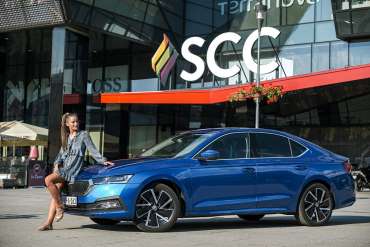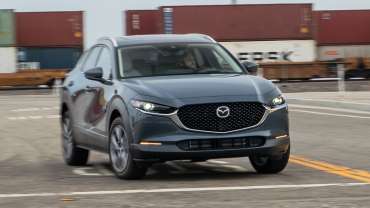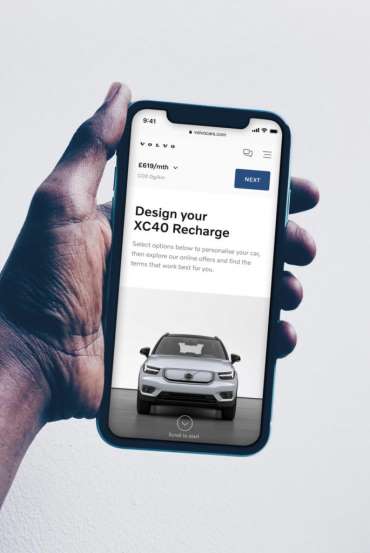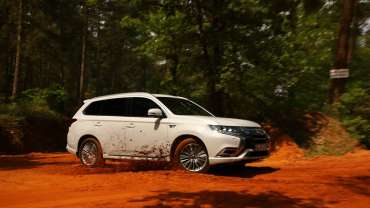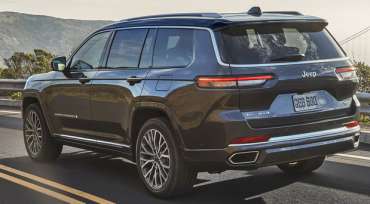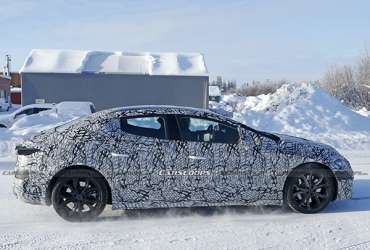
Worldcarblog.com
Skoda Octavia selected for "Family Car" as part of the selection for "Women's World Car of the Year"
The SKODA OCTAVIA won the “Women's World Car of the Year 2020” award in the “Family Car” category.
This is the first success for the Czech car manufacturer within this international award, which is being awarded for the tenth time this year, and which is awarded exclusively by professional car journalists. As one of a total of nine winners in individual categories, the ŠKODA bestseller is now competing for the main prize: the winner of the main award "Women's World Car of the Year 2020" will be announced on March 8 on the occasion of International Women's Day. The jury consists of 48 journalists from 38 countries from Argentina to New Zealand.
The "Women's World Car of the Year" award has been given since 2011, and the jury consists exclusively of professional car journalists. This year, 48 members of the jury from 38 countries evaluated all nine models that were presented between January and December 2020, and first nominated three finalists in each of the nine categories at the beginning. In the "Family Car" category, the OCTAVIA model won and thus qualified as a candidate for the main prize.
The evaluation criteria are, for example, safety, quality, price, design, driving comfort and environmental friendliness.
2020 Mazda CX-30 Road Trip Review: When Driving Doesn’t Matter
On the open road, our long-term Mazda CX-30 keeps its driver involved—too involved.
Mazda no longer uses "Driving Matters" as its tagline (now it's "Feel Alive"—already do, thanks), but that ethos is still imbued in every one of its vehicles. We agree with that mantra—mostly. Sometimes we'd trade involvement for relaxation, particularly when enduring long highway stretches as we've now done for several thousand road trip miles in our long-term 2020 Mazda CX-30. Turns out that when driving doesn't matter, this subcompact crossover is less than ideal.
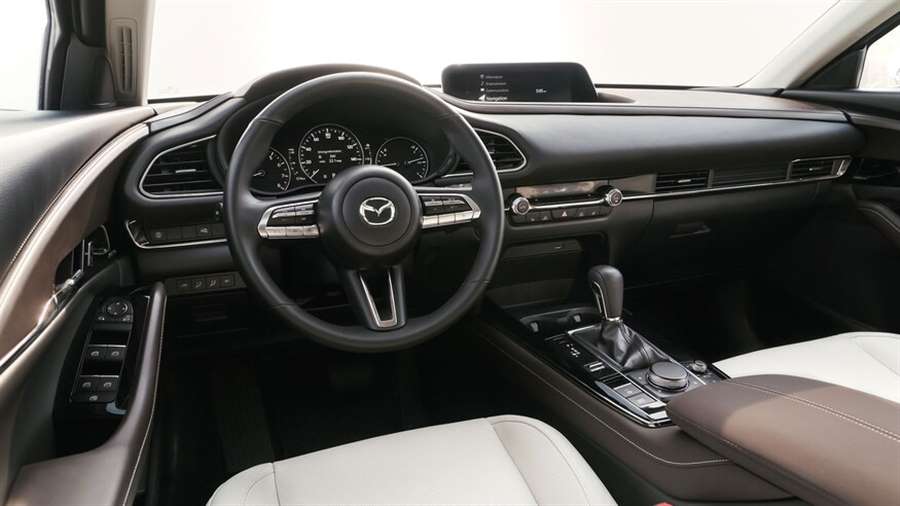
Nice as the CX-30's accurate, reactive steering is on a twisty road, managing it becomes a chore when coursing dead ahead. Lane-keep assist can be an awesome help in these scenarios, and the CX-30's spec sheet shows it as standard equipment. But on my recent drive between Los Angeles and San Francisco it did basically nothing, providing such minimal assistance that I checked a few times to see if it was turned on (it was). Other than gentle nudges seemingly at random, lane keep assist would allow the car to drift across markers with nary a beep. Autopilot this absolutely isn't.
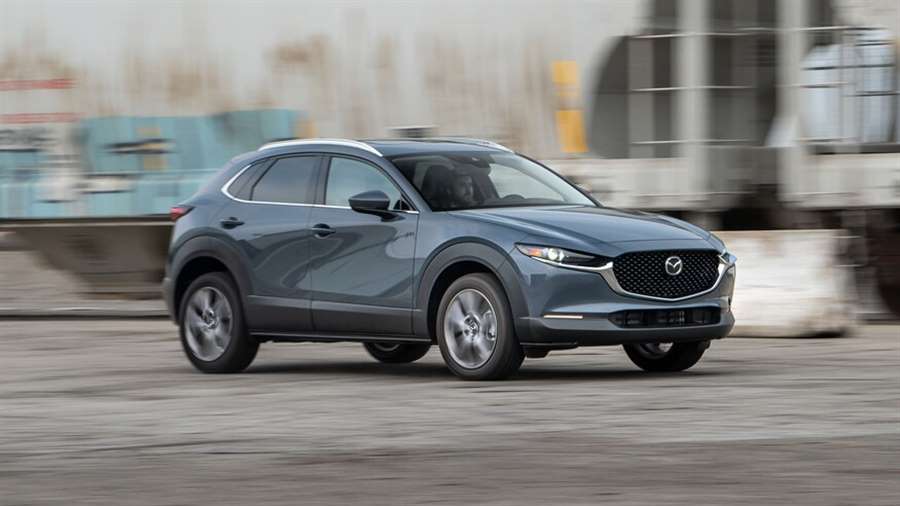
The CX-30 is also equipped with adaptive cruise control, which I came to call brake-check assist because of how committed it is to resuming its set speed after accelerating to pass. Instead of coasting down, the CX-30 brakes to reduce speed, causing some drivers I passed to brake in response. I'd have to override the car's action by applying throttle myself. Eventually I started turning adaptive cruise control off when passing, lest other drivers think I had a bone to pick—all involvement that systems like these are intended to negate. At least the blind-spot monitors effectively detect vehicles obstructed by the huge D-pillars.
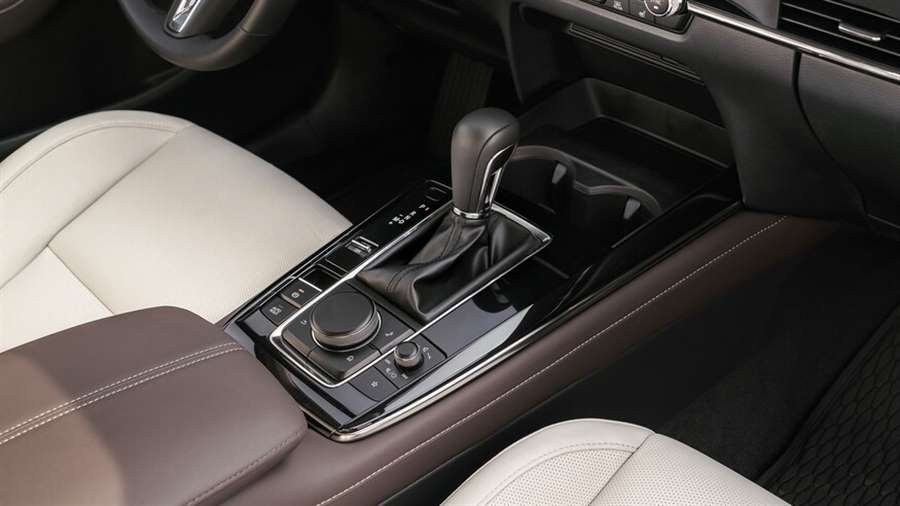
How Far Can The CX-30 Go On A Tank Of Gas?
Our logbook shows that the CX-30 struggles to cover more than 300 miles between fill-ups. I eked out 317 miles at best, but photographer Darren Martin reported refueling every 280 miles or so on his hilly trek from Los Angeles to Oregon. Given its 12-gallon tank, the CX-30's approximately 25-mpg average isn't impressive for a subcompact SUV. Long-haulers might find this Mazda's range frustratingly small, but I don't mind stopping to stretch about that often.
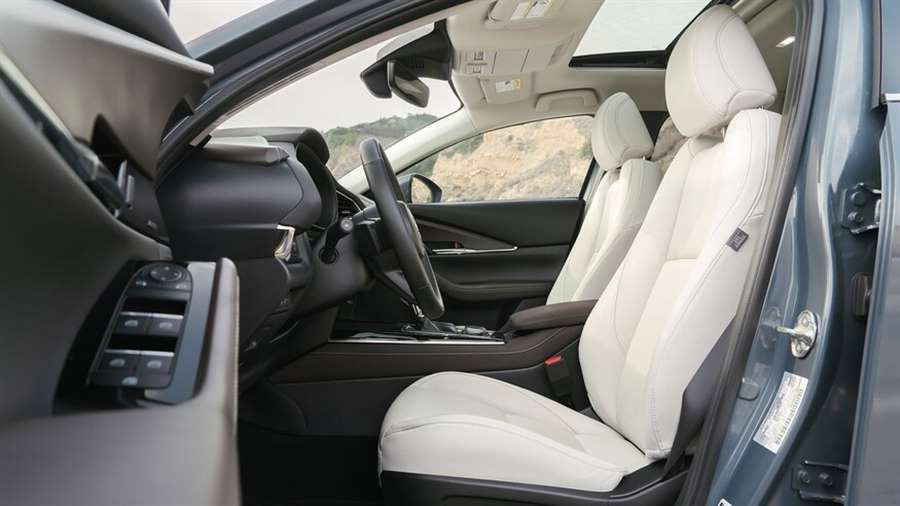
Thankfully the driver's seat kept my stretch breaks from becoming lengthy vinyasa sessions. The CX-30's front seats don't look all that special, but they feel excellent, providing ergonomic support all down the back. Their padding is neither too firm nor too plush, insulating nicely against the often busy ride. Cushy armrests and a leather-wrapped steering wheel made the CX-30 a nicer place to pass the miles.
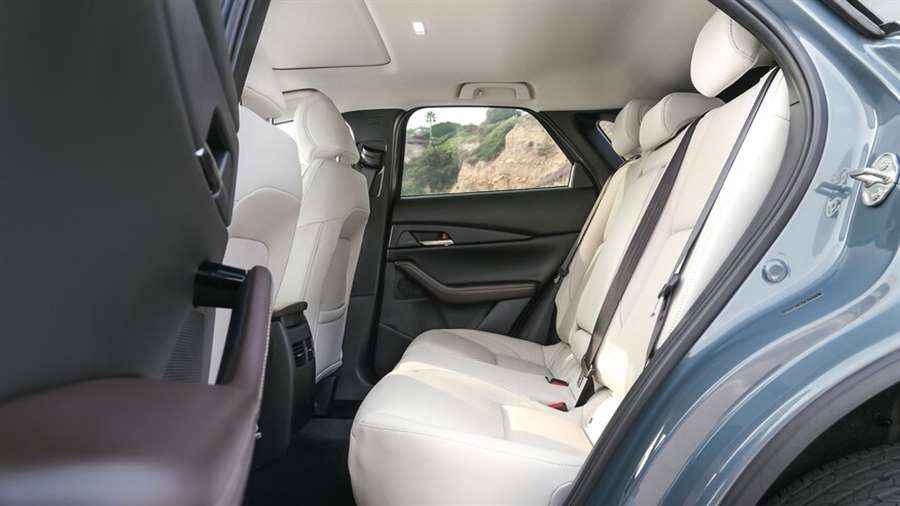
Too Sporty For Its Own Good?
On my solo road trip the CX-30 was just spacious enough to fit my luggage in the passenger seat and wheels-removed mountain bike over the folded-down second row. Fortunate that was, as my long weekend concluded with a trail ride in Santa Cruz. Carving toward the coast over forested Highway 17, the CX-30's pep and agility reminded me why driving matters. But afterwards, drained and digesting a post-pedal burrito, I just wanted to chill. Little such luck—the Mazda's involving setup kept me overly alert for the next several hours.
Our experience indicates that the CX-30 is better for around-town zipping than long-distance cruising. We'll see if that balance shifts as we pack on more miles.
Volvo from 2030 on electricity only. And the possibility of shopping only online
Don't use the Internet and have nowhere to charge your car? Forget Volvo.
Okay, if you don’t use the Internet, you won’t read anything new and you won’t have anything to regret. But Volvo is really turning its business around.
From 2030, every new Volvo will be electric
News has arrived from Sweden that Volvo Cars will be committed to becoming leaders in the fast-growing premium electric car market with a plan to become a fully electric car company by 2030.
Until then, the company will gradually phase out models with internal combustion engines, including hybrids. At Volvo, they expect that legal solutions and the expansion of charging networks will enable this transition to electric cars.
For now, Volvo will only sell its electric vehicles online.
Volvo Cars last year launched its first all-electric car, the XC40 Recharge, in markets around the world. In the coming years, Volvo Cars will introduce several additional electric models. By 2025, the goal is for 50 percent of global sales to consist of fully electric cars, and the rest will be hybrids. By 2030, every car he sells should be fully electric.
And the role of the merchant?
The fight for clients is over - there will be nothing to negotiate here. The buyer buys the car at the price shown on the website, and the seller must prepare it, elegantly hand it over and then service it. In the meantime, they may organize a test drive to help those who are not satisfied by clicking on the page. Volvo emphasizes that the dealer network will be just as important as it is today, but the role of dealers will be limited because electric cars are much simpler. We wonder what interest the owners of car dealerships will have in this approach of the manufacturer?
New Mitsubishi Outlander PHEV review: the popular hybrid driven
The Mitsubishi Outlander is very much on trend. It's an SUV, and also a plug-in hybrid – but it actually arrived slightly ahead of its time. Here we're driving the current model, which is almost identical to the previous car aside from the lightest of facelifts and a few technological tweaks aimed at keeping ahead of emissions regulations. Why mess with success? It's an established big seller in Britain, although the rest of the range hasn't been doing so well, prompting plans for Mitsubishi to leave Europe. For now, though, this Outlander is a current model, available through the familiar dealer network. The question is, in a market that's now brimming with hybrid SUVs, does the
How can I spot a new Mitsubishi Outlander?
With difficulty. Mitsubishi’s goals for this version clearly didn’t include major styling changes. In fact, even sat next to a 2018-spec car, it takes a few moments to spot the newer LED headlights and the lightly tweaked front grille and bumpers. The new design for the wheels is the biggest giveaway.
Inside, there’s a tweaked instrument cluster, plus new air vents and a USB port for rear passengers.
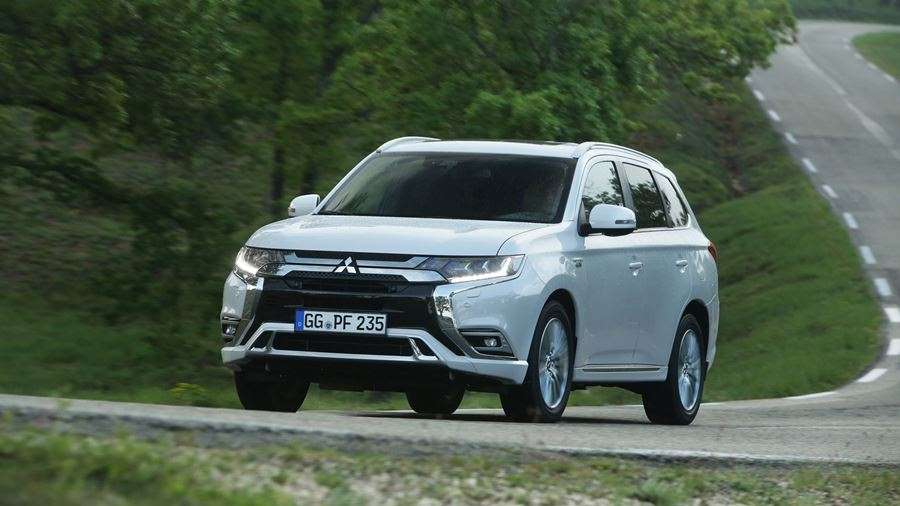
The sunroof has been relegated to the options list in an attempt to fend off the extra car tax premium buyers have to pay when pricing creeps above £40,000.
While we were impressed by the quilted leather upholstery on the seats of our test car, these are limited to the top-spec models costing north of £40k.
Still, the range starts at below £36k for the Verve, and the big-selling Dynamic version still comes in below £40k, and includes heated leather seats and a lot of safety and convenience equipment.
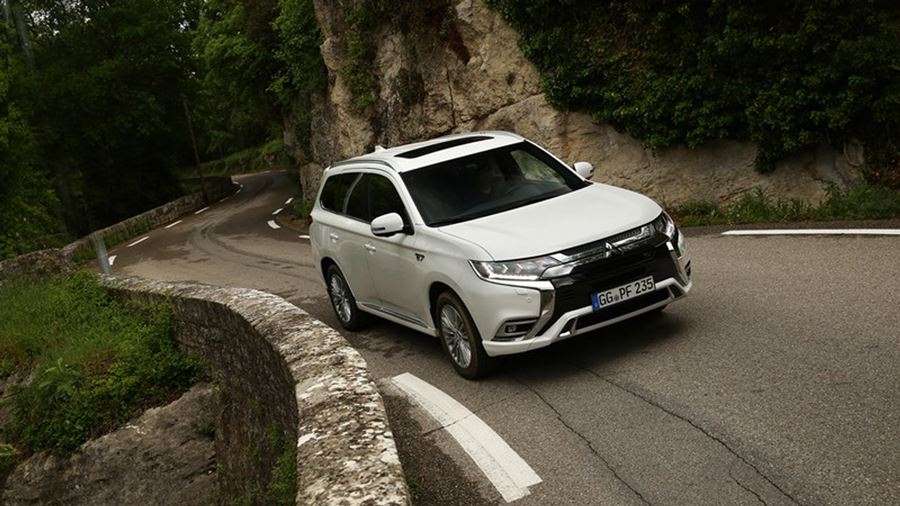
What’s the Mitsubishi Outlander hybrid like to drive?
It’s not that far removed from the previous generation, which we drove back-to-back with this latest verion, but in a couple of important respects improvements have been made. The first is in cabin refinement, because the current car is quieter, rides better and feels more solid than ever.
There’s been extra adhesive applied to the body-in-white (before painting) to strengthen the shell using an approach similar to that used in aircraft manufacture, and this has the effect of enhancing torsional rigidity, so the car flexes less through bumps and bends. The difference is slight, but worthwhile.
The tyres have changed from Toyo to Yokohama, there’s a quicker steering rack and the suspension has been recalibrated.
Doesn't sound like much of a big deal? But in fact the handling and body control have improved. The quicker steering is the most notable change, making this Outlander easier to thread through narrow roads. Road-noise intrusion levels have turned down a notch too.
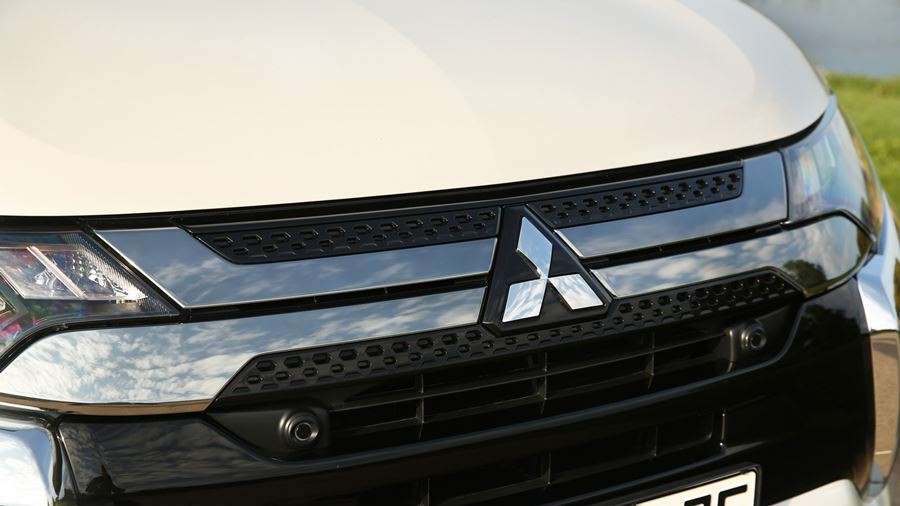
What has been sacrificed is the ride quality, which has become a bit busy on UK roads. It’s not uncomfortable by any stretch, but it feels far less settled than before. A fair trade-off for a bit more verve? Almost.
There’s a new Sport mode that offers a bit more punch, but this feels incongruous in light of the epic bodyroll that occurs when you hit a bend too quickly. An additional Snow mode prepares the capable chassis for slippery conditions.
You still get the paddles behind the steering wheel to adjust the brake regen’s effect, making one-pedal driving a possibility, and they’re still arguably backwards: the left one turns up the deceleration, whereas the opposite seems more intuitive.
Isn’t a new engine the biggest news here?
It would be, except it's rather a stretch to call this a new engine. Instead it’s an adaption of the old 2.0-litre petrol, with the latest Mivec (remember that badge from FTOs and Evos of yore?) variable valve timing added. The 2.4-litre engine can switch between Otto and Atkinson cycles, meaning it can make more power and torque when required (133bhp and 156lb ft up from 119bhp and 140lb ft in the 2.0) thanks to the extra CCs using the former cycle, but burn less fuel under lighter loads with the latter.
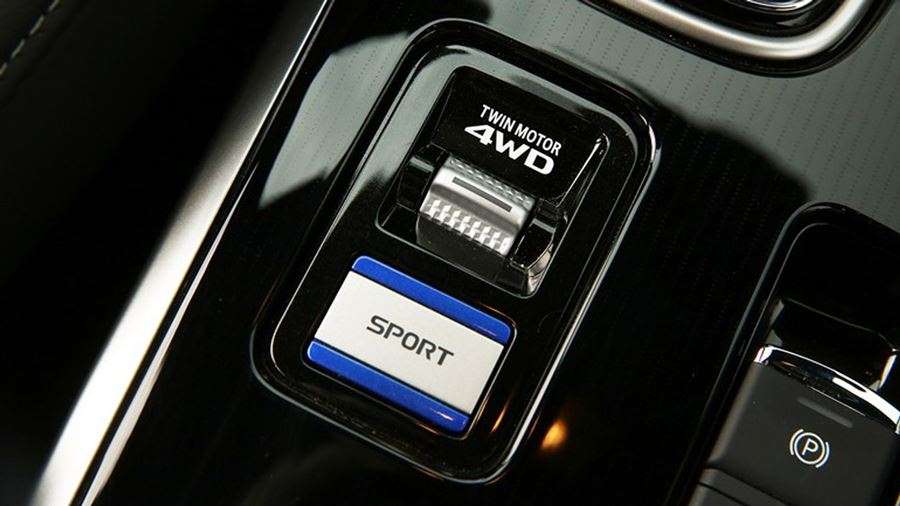
Which sounds great. And it is, except not literally. Put your foot down and you’re greeted with a monotone moan very similar to that of the old car, in that uniquely disappointing CVT fashion – lots of noise and not much acceleration. Only now, the noise is just a bit more distant than it used to be.
Funnily enough this isn’t a CVT either. It’s a fixed-gear system that drives power to the wheels, with a hydraulic clutch to modulate the electric twist provided by the twin motors. It’s built by GKN – the firm responsible for the Focus RS’s lively rear axle assembly, among many other applications.
The transmission catches up eventually and meaningful movement occurs, but it’s still no thoroughbred. The 0-62mph time has dropped 0.5 seconds to 10.5.
This engine revision plus work on the battery – which gets 10% more power output and total capacity of 13.8kWh thanks to new cells and better management – has allowed Mitsubishi to recalculate maximum electric range, fuel economy and CO2 emissions for the more realistic WLTP testing, and the results are more impressive for that reason. We’re talking 30 miles on electric power, 141mpg and 46g/km. You’re also able to drive faster on electric power – now 84 rather than 78mph.
The trade-off is it takes an extra 30 minutes to charge the car using a 16A/3.6kW charge point – this now takes four hours.
Mitsubishi Outlander hybrid: verdict
The latest Outlander PHEV doesn’t reinvent the wheel, but then it didn’t need to. It’s more relevant now than ever before as the push for plug-ins intensifies. And looking beyond the powertrain, the Outlander remains a decent if unexciting all-round package.
After Europe, the world chooses "Car of the Year": These are the semifinalists
After Europe chose "Car of the Year 2021", now follows the world selection. The semi-finalists are known, and we will get the finalists on March 30, while the ceremony of announcing the winner is expected on April 20. He looks at which car models are in the inner circle.
After we learned that the Toyota Yaris is the European "Car of the Year", the semi-finalists for the World Car of the Year have now been announced. The European winner is also shortlisted, and according to current estimates sent to this selection as the biggest candidates for victory, two electric models are also mentioned. Here is who is on the list:
- Audi a3
- BMW 2 Series Gran Coupe
- BMW 4 Series
- Honda e
- Kia K5
- Kia Sorento
- Mazda MX-30
- Mercedes GLA
- Toyota Yaris
- Volkswagen ID.4.
{vembed Y=G8vBBMooIW8}
At the same time, the selection for the "World City Car" is being held, and five finalists are known: Honda e, Toyota Yaris, Honda Jazz, Hyundai i10 and Hyundai i20.
Aston Martin DBX, BMW X6, Land Rover Defender, Mercedes S-Class and Polestar 2 were nominated for the title of the best in the class of luxury cars.
In the most interesting category of sports cars, the nominees are: Audi RS Q8, BMW M2 CS, BMW X5 M / X6 M, Porsche 911 Turbo and Toyota GR Yaris.
And finally, when it comes to design, these five models entered the semifinals here: Honda e, Land Rover Defender, Mazda MX-30, Polestar 2 and Porsche 911 Turbo.
The finalists will be announced on March 30, and the winner on April 20.
Stellantis could still cancel the Cherokee name
Jeep has been using the Cherokee label since 1974, and today it is found on two popular SUV models. In 2013, during the final days of the Chrysler Group era, before merging with Fiat, Cherokee officials told The New York Times that no one had consulted them before Jeep renamed Liberty the Cherokee.
According to Hot Tires, under the roof of Stellantis, after the merger of FCA and PSA, Jeep is facing increased pressure to abolish the use of the name of the Native American people. Even Hoskin Jr., the head of Cherokee, said earlier that "Jeep respectfully refused" to change the name. However, The Wall Street Journal, after talks with the head of Stellantis, Carlos Tavarez, now reports that this radical option has not been completely rejected. Although the world's number one carmaker is unsure if there is a "real problem" with the use of the Cherokee name, he has promised that disagreements will be resolved, if any: "If there is a problem, of course we will For now, he doesn't see "anything that could turn out to be negative," adding that the "Cherokee" label represents "Jeep's way of creating passion, our artistic abilities."
Carlos Tavarez continued, saying that Stellantis and Jeep are "ready to accept everything, to the point where we make decisions with the right people and without intermediaries." The newly formed concern is fully aware that this is a topic that should be taken lightly, given the popularity of Cherokee and Grand Cherokee. Not only that, but there is also a new Grand Cherokee L seven-seater, which will arrive in 2022, which will also have to get a new name.
The renewed negotiations between Stellantis and Cherokee stem from a statement made by Chuck Hoskin Jr. in February: "I'm sure the intentions are good, but it doesn't do us any honor to have our name attached to the side of the car." The new name would be a big undertaking in terms of marketing, but it seems that Carlos Tavarez is open to the idea of rebranding his successful SUV models.
Mercedes-Benz EQE Will Be Smaller Than The E-Class
Mercedes-Benz is going all-in on their EQ line of vehicles, with six new cars confirmed to launch over the coming months and years. We’ve already seen spy shots of the EQS Sedan, which will be unveiled later this year. This time it’s the turn of the smaller EQE Sedan.
The EQE Sedan will be the second car to use Mercedes‘ new Electric Vehicle Architecture (EVA). Like the EQS Sedan, it’ll follow the hierarchy set by their legacy models, meaning that the EQE will play in the same segment as the E-Class.
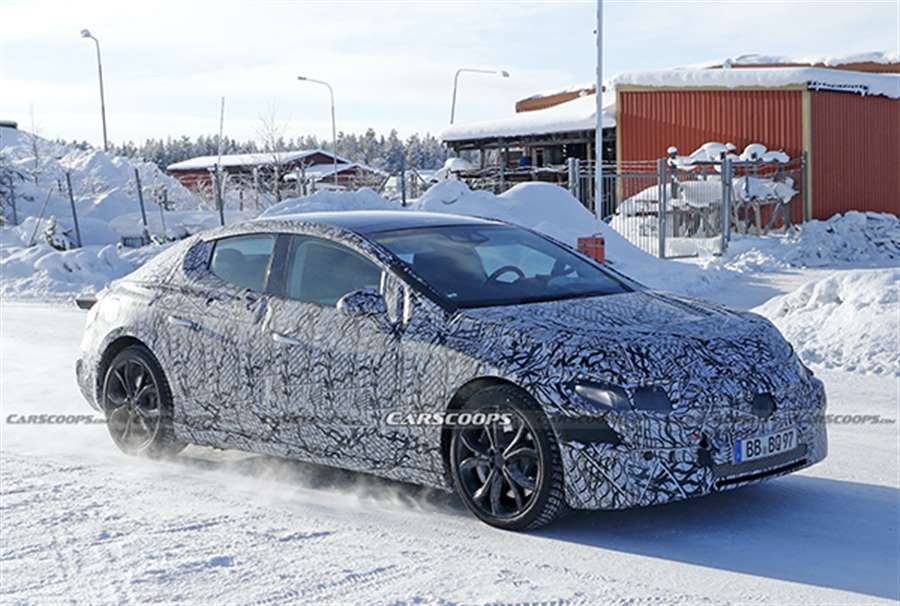
However, the EQE won’t just be a simple rework of the E-Class body shell. It will be based on the new Modular Electric Architecture (MEA) and feature a swoopy cab-forward design, as we’ve seen with the EQS, inspired by the Mercedes Vision EQS concept car.
Like the EQS Sedan, the EQE Sedan (codenamed V295) will spawn an SUV variation. In what could prove to be a confusing naming convention, this soft-roader be called the EQE SUV.
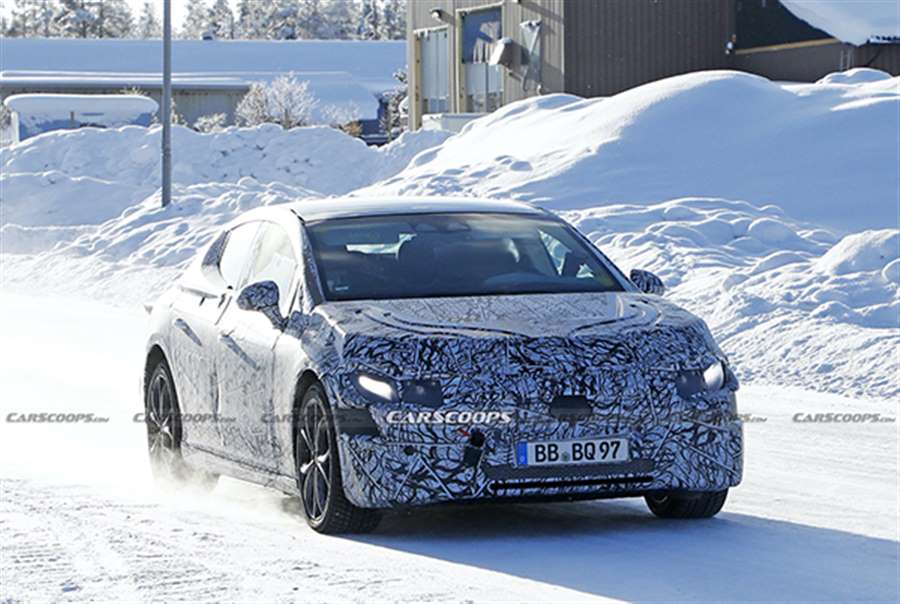
From these images, it’s evident that the EQE is smaller in overall diameter than the EQS Sedan, with our spy photographers noting that it may even be slightly shorter overall than the current E-Class. But, thanks to the EVA platform’s flat-floor design, the interior is likely to be more spacious than the ICE-power car.
The EQE also offers a “proper” boot, unlike the five-door lift-back style featured on the EQS. The side profile’s most striking feature is how the beltline sweeps up in a manner not often seen in a Mercedes-Benz design. That said, the heavy camouflage and body panel disguise would indicate that the outlines of the rear quarter panels and the hood are not to be believed just yet.
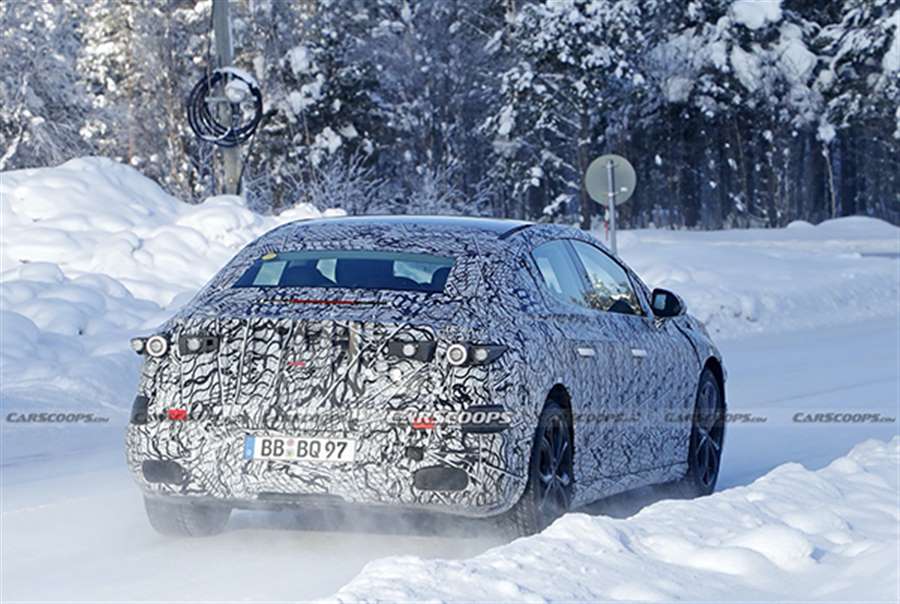
The interior is expected to feature a version of the forthcoming MBUX Hyperscreen. The boundary-breaking dashboard features three screens sitting under one massive expanse of glass. The glass stretches from door to door and allows the front-seat passenger to have their own dedicated display.
Powertrains are yet to be confirmed, as the car itself looks set to be a 2022 model. What we expect, though, are twin motor setups with all-wheel drive. The German carmaker aims to offer the bigger EQS Sedan with a driving range of up to 435 miles (700 km), so expect to see similarly impressive figures from the EQE as well.
There’s also a strong likelihood that we’ll see AMG models of the EQE Sedan as well, set to take on the likes of the Taycan, e-tron GT, and Tesla Model S. Read more > https://mercedes-world.com/eq/mercedes-benz-eqe-e-class

